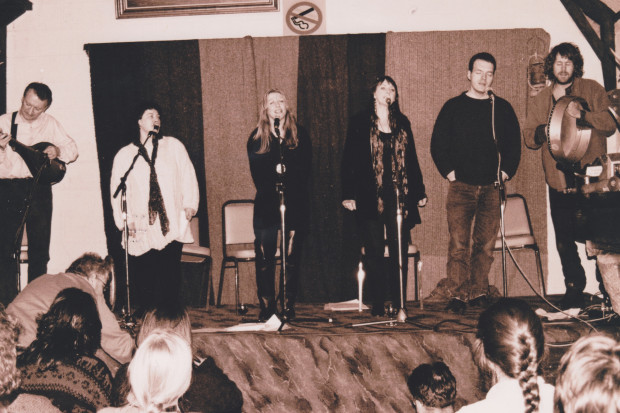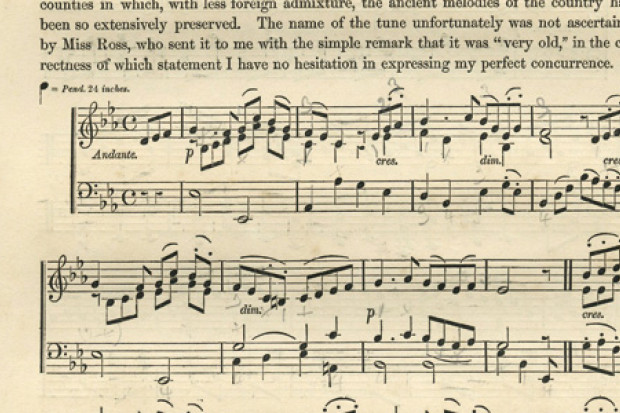Editorial: John Blacking
I haven’t spoken to many other traditional musicians who undertook a music degree so I don’t know how representative my experience is, but it seems appropriate at the moment to introduce into the magazine this particular aspect of Irish third-level music education. I do think that the integration of traditional musicians into third level is a healthy development for both traditional music and Irish music education, not simply because a traditional musician may come out conversant with the wider world of music (you don’t need a music degree to do that), but because traditional music itself, for it to be a healthy and interesting art-form, needs its practitioners to constantly re-evaluate what they are trying to do and why. A decent third-level music environment, whether it is ideally suited to them or not, is going to shed light on a lot of old cobwebs and force an examination of passed-on knowledge. After that it is basically up to the traditional musician and whether they are willing to go down that questioning route, or stick with their inherited wisdom.
No doubt due to the academic and classical music environment that I was in at third-level, I and others specialising in traditional music felt that we had something to prove. A combination of our own culturally-instilled insecurities about this music, alongside the generally ill-defined status that it had in a classical music and academic environment, meant this music, for us, was in no-man’s-land. Some of us felt compelled to read voraciously, seeking some sort of ‘philosophy of Irish traditional music’ that would stand up to the hardy bases that backed classical music. But once we’d consumed the very small amount that had been written on Irish traditional music at that time (I attended college from 1992-96), I found there was few places left to go. Few who were writing serious books or articles on Irish arts and culture made any sizable reference to Irish music, and there was rarely a book published on the subject. Critically isolated, therefore, those who were carting traditional music through music degrees as students could find that their critical resources were low and their inherited traditional music reasoning was prone to falling in on top of itself. There were of course plenty of American and British academic music journals, but it was hard to find one that wasn’t overly dense or inaccessible, and the subjects that were discussed and the ‘conclusions’ that contributors came to were, I felt, predominantly bland.
Eventually, I stumbled upon the work of the ethnomusicologist John Blacking. In his writings I felt I had at last found a possible basis for starting to properly understand our own music, or at least a writer who prompted you to ask productive questions. Up until then we’d been fed a diet of Breathnach and Ó Canainn, but they tended to keep matters at surface level. Blacking encouraged the reader to apply – to all genres of music –a simple commonsence view of music, always starting with basics (in fact, the first book of his that I read was called A Commonsense View of AIl Music, published in 1987). Even now, I enjoy glancing through the headings and subheadings in some of his work, for example, ‘What is music?’, ‘Expressing human experience through music’, ‘The relationship of music to cultural and social organization’. These were indeed all the things that we needed to know. Blacking’s thinking suggested that, no matter what the genre of music, it was to be approached as something simply representative of human experience, for that is what music is.
He had an extraordinarily refreshing philosophy on music. He would start at the bottom and build up. There were no prior assumptions. All received knowledge was open to scrutiny. He thought about music on its on terms, regardless of styles, fashions or consensus. For example, the polarisation between art-music and folk-music, with its accompanying ‘sophisticated’/’primitive’ vocabulary, was prime Blacking territory. He suggested that the term ‘folk-music’ should be used to describe music that enhanced a social occasion, while ‘art-music’ could be used to describe music when it was actually the reason for the social occasion. Thus, to take some contemporary examples, the performance of composer James Wilson’s Fanfare at the opening in April of the CMC’s premises would, in Blacking’s thinking, be termed folk-music, while fiddler Frankie Gavin’s performance on stage at the year’s Galway Arts Festival would be art-music. This may all sound unnecessary and academic, but you cannot imagine the revelation that such thinking was for traditional musicians passing through what was fundamentally a classical-music shaped degree, and who had previously resigned themselves to being ‘folk-musicians’, accepting all the ambiguity that in the late twentieth century that label could bring. Suddenly, the gulf between classical and traditional, folk-music and art-music, began to dissolve before our eyes.
After that myself and my colleagues were sold on Blacking for good. So you can imagine my surprise when I discovered that this great intellect, who had solved and encouraged us to solve for ourselves many dilemmas concerning Irish traditional music in the modern world, had spent much of his career lecturing and heading up a course in the Queen’s University of Belfast! Moreover, he had died aged only 62 in 1990. I regret that I missed out on the opportunity of studying under him, but even more so, I have always felt it be painfully ironic that this great thinker never applied himself to analysing Irish traditional music, even though he was living on this island for much of his career. The only piece of writing I ever read by him on this subject was a review of Breandán Breathnach’s Folk Music and Dances of Ireland that appeared in an issue of Éigse Cheol Tíre/Irish Folk Music Studies in the seventies. But yet, that short little piece brilliantly demonstrates his enlightened approach towards understanding music.
Blacking was intrigued by the discussion of ornamentation, variation and styles in Breathnach’s book. He pushed it further though, encouraging the reader to question what the social significance of these minutiae might actually be. He went beyond talking about traditional music as if it was simply the result of building blocks falling in on top of each other through history. He insisted on getting underneath the skin of it. He wanted to know how the intricate detail in a performance of traditional music expressed human experience. How often in Irish traditional music do we come across such probing thought? We rarely go beyond the right and the wrong, the new and the old. To the traditional musician, Blacking’s insights can be supremely satisfying, essentially because he is poking around in exactly the same area that the creative process is actually at work. The brilliant simplicity of Blacking’s concept of music can be lodged side-by-side with the very complex, but often sub-conscious, questioning and working out that occupies the musician when they are playing. The inclusion of traditional musicians at third level is important for all sorts of obvious reasons. And I’m sure that gradually a curriculum is being worked out that is wholly satisfying to them. My only hope is that a knowledge of the work of John Blacking will never be left to chance again.
Published on 1 July 2001
Toner Quinn is Editor of the Journal of Music. His new book, What Ireland Can Teach the World About Music, is available here. Toner will be giving a lecture exploring some of the ideas in the book on Saturday 11 May 2024 at 3pm at Farmleigh House in Dublin. For booking, visit https://bit.ly/3x2yCL8.












